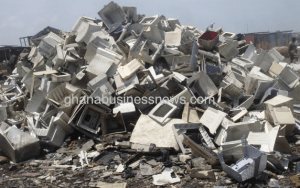
The subject of e-waste dumping in Ghana is continuously contentious. The subject often puts Ghana in bad light, but an article in a scientific journal on the subject of e-waste for the first time, is showing a remarkably positive thing about e-waste in Ghana. E-waste is pumping a substantial amount of money into Ghana’s economy, the article says.
According to the article in the Seattle Journal of Environmental Law, published May 31, 2015, 10 to 13,000 metric tonnes of e-waste is processed in Accra annually, these contribute about $105 million to $268 million into Ghana’s economy.
The article points out that e-waste also sustains between 121,800 and 201,600 people in Ghana, from the 250,000 metric tonnes that enters Benin, Côte d’Ivoire, Ghana, Liberia, and Nigeria annually despite the presence of efficient recycling facilities in Europe, and state laws requiring otherwise.
The article, authored by Erin McIntire, a law student of Seattle University, notes the adverse economic, environmental and human health effects of e-waste on Agbogbloshie, Ghana’s e-waste dump, and the nearby Korle Lagoon.
Mercury from computer monitors, sometimes used as “stepping stones” to cross narrow points of the Korle lagoon, is identified as a major source of pollution that contributes to the blackening of what is one of the most polluted water bodies in the world. Some mercury also enters the water through being vaporized first into the air by the burning of e-waste.
Lead and cadmium also contaminate the soil and water and end up in biological systems.
The presence of poisonous chemicals in the soil and underground water, though has been established by the Greenpeace. In 2008, the environmental group did a lab test of the soil and water at Agbogbloshie, and the results showed that the soil in the area contained toxic chemicals at levels a 100 times more than World Health Organisation allowable limits.
The comprehensive report on e-waste in Ghana published in March 2011 found that all the remaining fractions after extracting the valuable components are dumped and/or burnt on the areas nearby. The dumping and open burning of hazardous fraction has negative effects on the environment and health of the WEEE handlers/workers and other people, who live in, work in or visit the neighborhoods of such sites.
The article also cites studies that associate blood lead levels of less than10 μg/dl (microgram per decilitre of blood) to impairment of cognitive development in children, and others that associate 10μg/dl of blood lead with a 2 or 3 point decrease in IQ.
“Because e-waste dumping sites give young children continuous exposure to neuro-toxicants, these young children will likely suffer larger IQ deficits and more permanent neurological damage, including memory loss, hyperactivity, and deficits in the ability to pay attention”, the article said.
Children are not strangers to the e-waste dump in Accra and the business. Some walk barefooted and without any protective clothing in dismantling e-waste, making them prone to cuts and abrasions; and exposing them to harmful flame retardants that are known to cause brain damage, kidney damage, skin damage, chronic gastritis, gastric ulcers and respiratory illnesses like lung cancer.
Meanwhile,The Basel Convention, to which Ghana is a signatory, requires countries to take “appropriate measures” in reducing the generation of hazardous wastes to a minimum, “taking into account social, technological, and economic aspects.”
However, some Ghanaian public officials are on record to have denied that there is e-waste dumping in Ghana.
The only scientifically produced report on e-waste in Ghana published in 2011 found that 171,000 tons of e-waste reaches the country’s informal recycling sector, adding that the amount of material that reaches the formal recycling sector accounted only for 0.2 per cent.
The report on Ghana, by Green Ad, a Ghanaian NGO, the Environmental Protection Agency (EPA) of Ghana and the Swiss Federal Laboratories for Materials Testing and Research (EMPA) notes that, “there are a number of laws and regulations that have some relevance to the control and management of hazardous wastes, including e-waste, “but they do not address the dangers posed to humans and the environment from such wastes.”
Information available to ghanabusinessnews.com however, indicates that an E-waste Bill has been prepared and should have been submitted to Cabinet by November 2013, but nothing has been heard about it since then.
A new report released August 30, 2015 by the United Nations and INTERPOL says only a third of Europe’s electronic waste is properly recycled, with vast numbers of cellphones, computers and televisions illegally traded or dumped.
The 35 per cent, the report indicates, amounts to 3.3 million tonnes of 9.5 million tonnes of used but still functioning and waste electronics and electrical equipment discarded by companies and consumers in 2012 which wound up in official collection and recycling systems.
The other discarded electronics, according to the report, some 6.2 million tonnes in all – was either exported, recycled under non-compliant conditions or simply thrown in waste bins.
The study estimates that 1.3 million tonnes of discarded electronics departed the EU in undocumented mixed exports, of which an estimated 30 per cent, that is about 400,000 tonnes was electronic waste; and 70 per cent functioning equipment.
It notes that more than 10 times the 400,000 tonnes of e-waste exported – some 4.7 million tonnes – was wrongfully mismanaged or illegally traded within Europe itself.
The research found that even in the few EU member states with robust, effective reporting systems, monitoring of de-pollution efforts and up-to-standard treatment conditions are not always securely in place.
While the article in the Seattle University Law School journal has revealed an important economic factor – the claim of how much e-waste pumps into the Ghanaian economy needs to be thoroughly questioned and re-examined.
By Emmanuel K. Dogbevi & Emmanuel Odonkor
Copyright © 2015 by Creative Imaginations Publicity
All rights reserved. This article or any portion thereof may not be reproduced or used in any manner whatsoever without the express written permission of the publisher except for the use of brief quotations in reviews.
